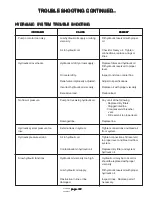
page 76
page 76
page 76
page 76
page 76
275B SER
800-00152
ELECTRICAL MOTOR MAINTENANCE CONTINUED...
ELECTRICAL MOTOR MAINTENANCE CONTINUED...
ELECTRICAL MOTOR MAINTENANCE CONTINUED...
ELECTRICAL MOTOR MAINTENANCE CONTINUED...
ELECTRICAL MOTOR MAINTENANCE CONTINUED...
ELECTRICAL CONNECTIONS
ELECTRICAL CONNECTIONS
ELECTRICAL CONNECTIONS
ELECTRICAL CONNECTIONS
ELECTRICAL CONNECTIONS
OVERLOAD RELAYS AND TRIP TIME
OVERLOAD RELAYS AND TRIP TIME
OVERLOAD RELAYS AND TRIP TIME
OVERLOAD RELAYS AND TRIP TIME
OVERLOAD RELAYS AND TRIP TIME
The National Electrical Code specifies an overload relay in each phase of the three phase power supply to protect the
motor against excessive input current caused by the following:
Overloading - Overloading a motor causes excessive input current which increases motor temperatures, shortens stator
life, and can cause an overload burnout.
Voltage Variation (From Nameplate) -Excessively high voltage increases idle current by 25 to 50%.
Excessively low voltage increases load current by 10% or more.
Voltage Unbalance (Between Phases) - A voltage unbalance of 3.5% can result in a current unbalance and temperature
increase of 25%.
Single Phasing -When starting, single phased motors develop no torque and draw high current. Single phasing under
load approximately doubles the load current.
Overload relays should be sized per the instructions of the starter manufacturer. In general, sizing of overload relays is
based on a percent of motor nameplate full load current depending on the type of starter.
Under normal conditions, overload relays provide protection btween 110 and 120% of their current rating. No extra
allowance for service factor is necessary.
On across the line starting, the trip time for properly sized overload relays should be approximately 15 seconds under
locked rotor current conditions of 600 % full load current. If the starting rime goes beyond 15 seconds, the overload
relay should disconnect the motor from the line to prevent motor stator overload burnout.
Oversizing the overload relay is NOT the way to eliminate excessive tripping. Eliminating excessive voltage drop,
reducing starting time and properly sizing the motor are correct answers.
For details on starting limits relating to time, frequency high inertia loads, or for across the line and reduced voltage
starting methods, consult Barko.
MAINTENANCE
MAINTENANCE
MAINTENANCE
MAINTENANCE
MAINTENANCE
Periodically inspect your motor for excessive dirt, friction or vibration. Dust may be blown from inaccessible locations
using compressed air. Be sure the drain holes in the motor are kept open and the shaft slinger is positioned against
the end bracket.
Grease or oil can be wiped by using a petroleum solvent.
Overheating of the bearing caused by excessive friction is usually caused by one of the following factors:
1. Bent shaft.
2. Excessive belt tension.
3. Excessive end or side thrust from the gearing, flexible coupling, etc.
4. Poor alignment.
Damaging vibrations can be caused by loose motor mounting or misalignment resulting from the settling or distortion of
the foundation, or it may be transmitted from the driven machine. Vibration may also be caused by excessive belt or
chain tension.
See the Parts Manual for electrical motor setup and parts breakdowns.

























